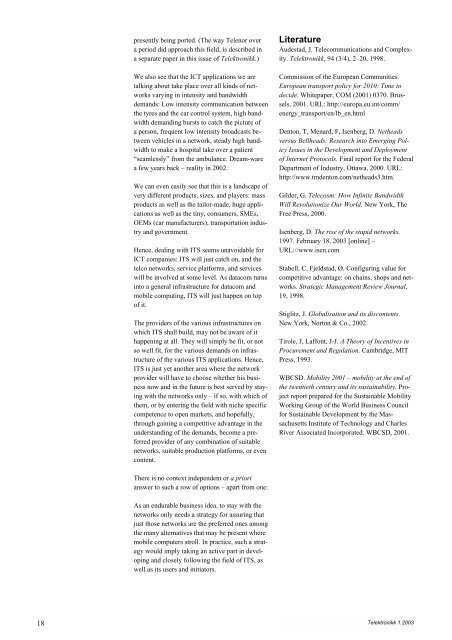Intelligent Transport Systems - Telenor
Intelligent Transport Systems - Telenor
Intelligent Transport Systems - Telenor
Create successful ePaper yourself
Turn your PDF publications into a flip-book with our unique Google optimized e-Paper software.
18<br />
presently being ported. (The way <strong>Telenor</strong> over<br />
a period did approach this field, is described in<br />
a separate paper in this issue of Telektronikk.)<br />
We also see that the ICT applications we are<br />
talking about take place over all kinds of networks<br />
varying in intensity and bandwidth<br />
demands: Low intensity communication between<br />
the tyres and the car control system, high bandwidth<br />
demanding bursts to catch the picture of<br />
a person, frequent low intensity broadcasts between<br />
vehicles in a network, steady high bandwidth<br />
to make a hospital take over a patient<br />
“seamlessly” from the ambulance. Dream-ware<br />
a few years back – reality in 2002.<br />
We can even easily see that this is a landscape of<br />
very different products, sizes, and players: mass<br />
products as well as the tailor-made, huge applications<br />
as well as the tiny, consumers, SMEs,<br />
OEMs (car manufacturers), transportation industry<br />
and government.<br />
Hence, dealing with ITS seems unavoidable for<br />
ICT companies: ITS will just catch on, and the<br />
telco networks, service platforms, and services<br />
will be involved at some level. As datacom turns<br />
into a general infrastructure for datacom and<br />
mobile computing, ITS will just happen on top<br />
of it.<br />
The providers of the various infrastructures on<br />
which ITS shall build, may not be aware of it<br />
happening at all. They will simply be fit, or not<br />
so well fit, for the various demands on infrastructure<br />
of the various ITS applications. Hence,<br />
ITS is just yet another area where the network<br />
provider will have to choose whether his business<br />
now and in the future is best served by staying<br />
with the networks only – if so, with which of<br />
them, or by entering the field with niche specific<br />
competence to open markets, and hopefully,<br />
through gaining a competitive advantage in the<br />
understanding of the demands, become a preferred<br />
provider of any combination of suitable<br />
networks, suitable production platforms, or even<br />
content.<br />
There is no context independent or a priori<br />
answer to such a row of options – apart from one:<br />
As an endurable business idea, to stay with the<br />
networks only needs a strategy for assuring that<br />
just those networks are the preferred ones among<br />
the many alternatives that may be present where<br />
mobile computers stroll. In practice, such a strategy<br />
would imply taking an active part in developing<br />
and closely following the field of ITS, as<br />
well as its users and initiators.<br />
Literature<br />
Audestad, J. Telecommunications and Complexity.<br />
Telektronikk, 94 (3/4), 2–20, 1998.<br />
Commission of the European Communities.<br />
European transport policy for 2010: Time to<br />
decide. Whitepaper, COM (2001) 0370. Brussels,<br />
2001. URL: http://europa.eu.int/comm/<br />
energy_transport/en/lb_en.html<br />
Denton, T, Menard, F, Isenberg, D. Netheads<br />
versus Bellheads: Research into Emerging Policy<br />
Issues in the Development and Deployment<br />
of Internet Protocols. Final report for the Federal<br />
Department of Industry, Ottawa, 2000. URL:<br />
http://www.tmdenton.com/netheads3.htm.<br />
Gilder, G. Telecosm: How Infinite Bandwidth<br />
Will Revolutionize Our World. New York, The<br />
Free Press, 2000.<br />
Isenberg, D. The rise of the stupid networks.<br />
1997. February 18, 2003 [online] –<br />
URL://www.isen.com<br />
Stabell, C, Fjeldstad, Ø. Configuring value for<br />
competitive advantage: on chains, shops and networks.<br />
Strategic Management Review Journal,<br />
19, 1998.<br />
Stiglitz, J. Globalisation and its discontents.<br />
New York, Norton & Co., 2002.<br />
Tirole, J, Laffont, J-J. A Theory of Incentives in<br />
Procurement and Regulation. Cambridge, MIT<br />
Press, 1993.<br />
WBCSD. Mobility 2001 – mobility at the end of<br />
the twentieth century and its sustainability. Project<br />
report prepared for the Sustainable Mobility<br />
Working Group of the World Business Council<br />
for Sustainable Development by the Massachusetts<br />
Institute of Technology and Charles<br />
River Associated Incorporated. WBCSD, 2001.<br />
Telektronikk 1.2003
















